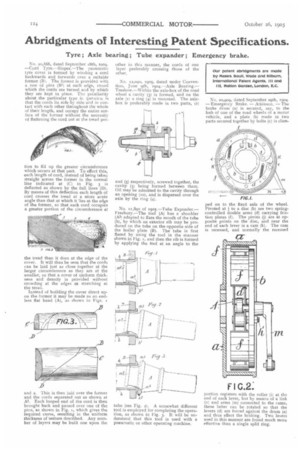Abridgments of Interesting Patent Specifications.
Page 20

If you've noticed an error in this article please click here to report it so we can fix it.
Tyre ; Axle bearing; Tube expander; Emergency brake.
No. 20,888, dated September 28t11, 1904. —Cord Tyre.—Sloper.—The pneumatic Lyre cover is formed by winding a cord backwards and forwards over a suitable former (B). The former is provided with a row of pins (IP) at each edge, round which the cords are turned and by which they are kept in place. The peculiarity about the particular type in questicii is that the cords lie side by side and in contact with each other throughout the whole of their length, and occupy the entire surface of the former without the necessity of flattening the cord out at the tread por
tion to fill up the greater circumference which occurs at that part. To effect this, each length of cord, instead of being taken straight across the former in the normal line indicated at (C) in Fig. 3 is deflected as shown by the full lines (D). By means of this deflection each length of cord crosses the tread at a rriore acute angle than that at which it lies at the edge of the former, so that each cord occupies a greater portion of the circumference at the tread than it does at the edge of the cover. It will thus be seen that the cords can be laid just as close together at the larger circumference as they are at the smaller, so that a cover of uniform thickness and density is provided without crowding at the edges or stretching at the tread.
Instead of building the cover direct upon the former it may be made as an endless flat band (A), as shown in Figs.
and 2. This is then laid over the former and the cords separated out as shown at A2. Each looped end of the cord is then brought back and passed over one of the pins, as shown in Fig. 1, which gives the required curve, resulting in the uniform thickness of texture described. Any number of layers may be built one upon the
other in this manner, the cords of one layer preferably crossing those of the other.
O. 12,040, igo5, dated under Convention, June 9th, mo4.—Axle Bearing.— Treskow.--Within the axle-box of the road wheel a cavity (3) is formed, and on the axle (1 a ring (4) is mounted. The axlebox is preferably made in two parts, (2)
and (5) respectively, screwed together, the cavity (3; being formed between them. Oil may be admitted to the cavity through an opening (to), and is dispersed over the axle by the ring (4).
No. 11,890 of 19o5.—Tube Expander.— Freebury.—The tool (A) has a shoulder (A3) adapted to flare the mouth of the tube (b), by which an exterior rib may be produced on the tube on the opposite side of the boiler plate (B). The tube is first flared by using the tool in the manner shown in Fig. 1, and then the rib is formed by applying the tool at an angle to the
tube (see Fig. 2). A somewhat different tool is employed for completing the operation, as shown in Fig, 3. It will be understood that this tool is used with a pneumatic or other operating machine. No. 20,909, dated September 29th, 1904. —Emergency Brake. — Atkinson. — The brake drum (a) is secured, say, to the hub of one of the road wheels of a motor vehicle, and a plate (b) made in two parts secured together by bolts (c) is clam ped on to the fixed axle of the wheel. Pivoted at j to a disc (b) are two spring. controlled double arms (d) carrying friction plates (f). The pivots (j) are at opposite points on the disc, and near the end of each lever is a cam (k). The cam is recessed, and normally the recessed portion registers with the roller (i) at the end of each lever, but by means of a link (n) and arms (m) connected to the cams, these latter can be rotated so that the levers (d) are forced against the drum (a) and thus effect the braking. Two levers used in this manner are found much more effective than a single split ring.




















